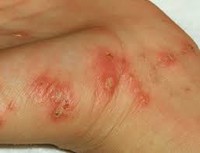507 Fishing Creek Road
P. O. Box 803
717-938-9577
717-938-2779 (fax)
Last updated: 10/23/17

large view |
What is scabies?
Scabies is an infestation of the skin caused by an itch mite. The microscopic scabies mite burrows into the upper layer of the skin where it lives and lays its eggs.
Scabies is found worldwide and affects people of all races and social classes. Scabies can spread rapidly under crowded conditions where close body and skin contact is frequent. Institutions such as nursing homes, extended-care facilities, and prisons are often sites of scabies outbreaks. Child care facilities also are a common site of scabies infestations.
What are signs and symptoms of scabies?
The most common symptoms of scabies are intense itching, especially at night, and a pimple-like skin rash. The rash also can include tiny blisters (vesicles) and scales. The itching and rash may affect much of the body or be limited to common sites such as the wrist, elbow, armpit, webbing between the fingers, nipple, penis, waist, belt-line, and buttocks.
Tiny burrows are sometimes seen on the skin. The burrows are caused by the female scabies mite tunneling just beneath the surface of the skin. These burrows appear as tiny raised and crooked (serpiginous) grayish-white or skin-colored lines on the skin surface. They are found most often in the webbing between the fingers, in the skin folds on the wrist, elbow, or knee, and on the penis, breast, or shoulder blades.
How does a person contract scabies?
- It is important to remember that a person who gets scabies usually have no symptoms during the first 2 to 6 weeks they are infested; however, they can still spread scabies during this time.
- Scabies usually is spread by direct, prolonged, skin-to-skin contact with a person who has scabies.
- Contact generally must be prolonged; a quick handshake or hug usually will not spread scabies.
- Scabies is spread easily to sexual partners and household members.
- Scabies sometimes is spread indirectly by sharing articles such as clothing, towels, or bedding used by an infested person; however, such indirect spread can occur much more easily when the infested person has more serious case of crusted scabies.
How is scabies treated?
- Products used to treat scabies are called scabicides because they kill scabies mites; some also kill eggs. Scabicides used to treat human scabies are available only with a doctor’s prescription.
- No “over-the-counter” (non-prescription) products have been tested and approved to treat human scabies.
- Bedding, clothing, and towels used by infested persons (or their household members, sexual partners, and close contacts) anytime during the three days before treatment should be decontaminated by washing in hot water and drying in a hot dryer, by dry-cleaning, or by sealing in a plastic bag for at least 72 hours. Scabies mites generally do not survive more than 2 to 3 days away from human skin.
- Fumigants are not recommended.
Please note that a person may experience itching for several weeks after treatment even if all the mites and eggs are killed. If itching still is present more than 2 to 4 weeks after treatment or if new burrows or pimple-like rash lesions continue to appear, retreatment may be necessary.